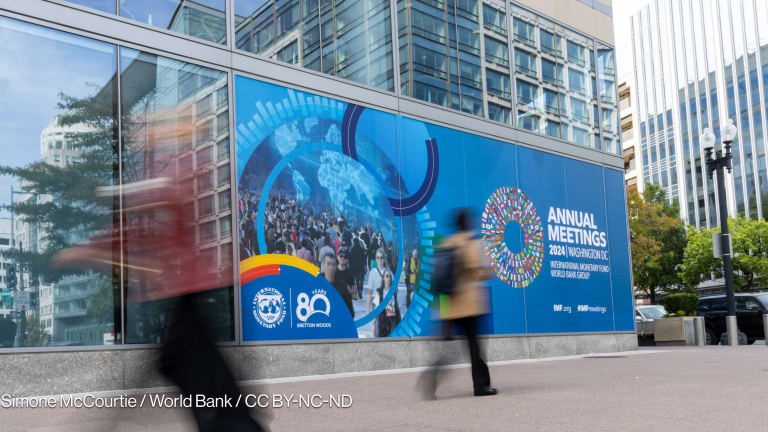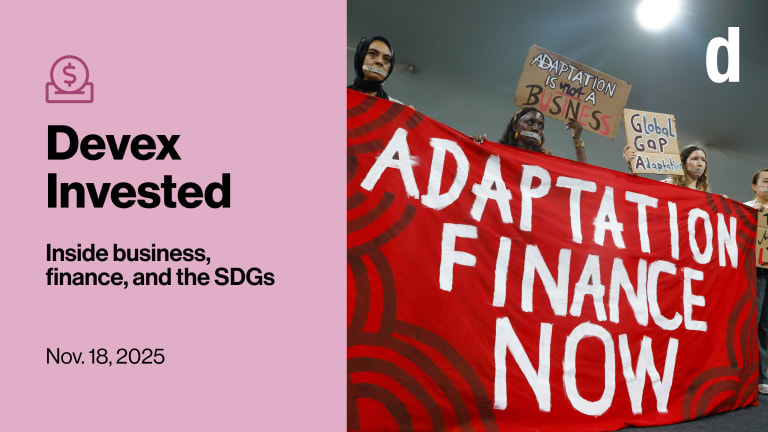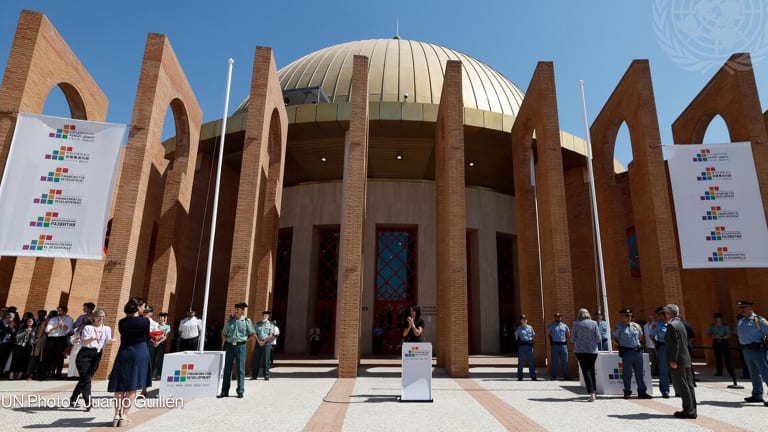SDRs and the RST: Explaining the acronyms of the IMF's currency system
Everything you wanted to know but were afraid to ask about the Special Drawing Rights and Resilience and Sustainability Trust at the International Monetary Fund. And how to avoid getting scammed.
They may sound like a rare disease, a rock band, or perhaps the latest crypto scam. However, SDRs and the RST are important players in the world of international finance — despite the clunky names and acronyms. Special Drawing Rights are a form of faux money that can translate into actual cash, while the Resilience and Sustainability Trust is a new fund for moving high-income nations’ excess SDRs into low- and middle-income countries to help fight climate change and fuel their development. Now then, let’s break it all down and explain where the International Monetary Fund (IMF — last acronym, I swear) fits in, and why this is being discussed at international summits from Bali to Sharm el-Sheikh — and, of course, in Washington, D.C. What are SDRs? Simply put, SDRs are assets created and issued to members by the IMF to boost global liquidity during times of duress and support reserves at nations’ finance ministries, treasury departments, or central banks — hence their being classified as reserve assets and not money. Governments can keep SDRs in their foreign exchange reserves to bolster their accounts or trade them for real cash to buy things like food and medicines. They may also be used to pay back debts to the IMF and sovereign lenders. But the SDRs issued are not loans — they don’t need to be paid back. How much is an SDR worth? SDRs’ value is determined daily based on a weighted average of a “basket” of major currencies, which currently comprises the U.S. dollar, the euro, the British pound, the Japanese yen, and the Chinese renminbi. It is the default currency denomination of the IMF — for example, when the fund makes loans, it’s all listed in SDRs. How many SDRs does my country get? When the IMF does a general SDR allocation, each member country gets a proportion relative to its quota share at the fund. The quota sizes generally reflect the size of any nation’s economy, though it is far from precise. Big picture, this means high-income countries tend to get relatively larger handouts. You can check the full list of nations’ share quotas here. Where did the SDRs come from? In short, magic. (No, not really.) But if you want to believe in magic or if you feel finance is all hand-waving anyway, skip the next paragraph. The longer answer goes back half a century. SDRs were proposed and instituted in the late 1960s amid doubts about the health of the U.S. dollar and worries about foreign reserve supplies — one newspaper dubbed them “paper gold.” Just a couple of years later, Washington abandoned the gold standard under then-U.S. President Richard Nixon. With the old Bretton Woods fixed exchange system dead and the new free-floating exchange rate activated, SDRs were soon therefore largely forgotten. However, the IMF now had the ability to create new SDRs, effectively out of thin air, as it were — so long as 85% of members’ total voting power is in favor. Like I said, magic (maybe, really). When did SDRs get revived as a tool to aid countries in distress? In 2009, in the wake of the global financial crisis and Great Recession, the IMF board decided to issue SDRs at the Group of 20’s request to help ensure global financial stability. Because the allocation is based on countries’ IMF share quotas, the lowest-income nations only got about $16 billion out of the $250 billion issued, but the issuance did help stabilize things. And then came the pandemic. With COVID-19 raging, the IMF in 2020 wanted to issue another tranche to help countries weather the downturn and use SDRs for purposes such as buying vaccines. Former U.S. President Donald Trump was not a fan — his aides worried about the SDRs going to China, Iran, Russia, and the like — and the idea was only brought to fruition after President Joe Biden took over at the White House in 2021. Some $650 billion worth of SDRs were disbursed in a general allocation in August 2021 — most of them, again, went to high-income countries. Low-income countries netted $21 billion. What is the RST? With low-income countries getting so little, you probably guessed correctly that high-income countries got a lot of SDRs. The IMF recently created the Resilience and Sustainability Trust as a fund where high-income nations could deposit excess SDRs — excess, in the sense that they don’t need SDRs to bolster their fiscal reserves because their finances are sound. The IMF can then take those SDRs and lend them to less well-off nations for long-term projects, such as climate-resilient infrastructure, at super low interest rates. So far, the RST, which officially was approved by the IMF board in April and operationalized in October, has seen donors pledge tens of billions in SDRs. The IMF board just approved the first deal, with Costa Rica, and two more — Rwanda and Barbados — are expected to have their deals sealed before the end of the year. Did the RST attract all those high-income nations’ SDRs? Some, but not most, and not the $100 billion aspirational goal. The U.S., the largest recipient, has not reallocated any of its SDRs, for example, due to a stalemate on Capitol Hill. Spain was the first country to pony up to the RST, seeding the fund. As of October, six higher-income countries had inked formal deals with the IMF to donate about $20 billion worth of SDRs, and another $37 billion was pledged by additional countries. Is this the first time the world tried an RST? No. After the Asian financial crisis in the late 1990s, some folks, including financier and philanthropist George Soros, had the idea to issue SDRs to countries in need as a way to shore up their finances and help fund so-called “global public goods,” such as fighting tuberculosis, through a dedicated fund. Soros called for $27 billion at the time. The idea looked a bit different to the RST, but 20 years later it seems to have come to life. Will more SDRs be created soon? Maybe, even though the odds at the moment are not favorable, especially without U.S. support. To create SDRs, the IMF needs approval from 85% of voting shares, giving Washington an effective veto as its 17% of voting power is always needed. There are arguments against issuing more SDRs. Firstly, the SDRs go to everyone, including dictators and regimes the U.S. does not love and who do not love the U.S., as well as high-income countries that don’t need them and are not rushing to reallocate the assets. Secondly, there is no accounting for the SDRs. Unlike programs at the IMF or World Bank — which have benchmarks, metrics, and oversight — the SDRs simply go to countries, no strings attached. Now, one might argue this is good, but politically, doing big handouts like this is a bit complicated. And economists worry that a blunt instrument, rather than targeted allocations, may not serve the best global interest. Are there risks to making more SDRs? Critics of SDR issuances worry they are akin to “printing money” by central banks and will be inflationary. There is not a ton of evidence to back this up, but it speaks to the zeitgeist amid concerns over price stability. More practically, Washington’s rivals, especially Beijing, getting chunks of assets make a new issuance politically messy. Whether or not China could actually use new SDRs it receives for its own purposes, or give it to friends, remains to be seen — SDRs are only meant to be used when a need is demonstrated. Who wants more? Well, who doesn’t like lots of shiny new SDRs? More seriously, especially among low- and middle-income nations, at least, there is a demand. In particular, middle-income countries are likely to want more SDRs, as they get larger chunks compared to the low-income countries, as SDRs are allocated based on each nation’s quota share at the IMF. Thus, the U.S. gets the most due to its 17.43% quota share, and Tuvalu gets just 0.001% of any allocation. Especially for countries with high debts, from Barbados to Ghana, the asset infusion can be a lifeline. Why is $650 billion a special number? It isn’t. It’s just that the U.S. executive branch is able to bypass congressional approval for an amount that was equal to this figure. If the IMF wanted more, Congress would have had to sign off — and that seems very improbable. The U.S. Treasury can only bypass Congress once per five-year cycle of the SDR basket review. For advocates of a new allocation there is some good news, as the last cycle ended at the end of 2021 and we are now in a new five-year cycle. Let the lobbying begin (hint: it already has). Have the SDRs been effective? Yes, without a doubt. SDRs have been used to prop up reserves and help countries facing balance of payment problems. Vital imports, from food to medicine, were secured using SDRs since last year’s allocation, even if the amounts going to some of the countries most in need were relatively small. However, it means much of the benefits of SDR allocation still relies on high-income countries effectively agreeing to move cash to lower-income nations. While holding SDRs does not cost anything, when a country trades them for money it incurs a small interest fee, which the IMF insists means they are “not ‘cost free.’” Can I use SDRs? No, you personally cannot. And if anyone is trying to sell you SDRs, they are likely a crook. Only sovereign countries and special institutions may hold and use SDRs, though some global industries, such as airlines, may use SDRs as the denomination for insurance purposes as a currency hedge. Which special institutions? Some institutions — such as the multilateral and regional development banks, and the IMF, of course, which is why it hosts the RST — are prescribed SDR holders; there are 15 such bodies in total. The banks are arguably well positioned to lend out money — it’s what they do — and have systems in place to monitor programs. The African Development Bank in particular has been hoping it will get an allocation from sovereigns. The catch is that European countries face European Central Bank rules against handing over their SDRs to the multilateral lenders. Countries outside the eurozone, though, are less constrained. Even if we don’t get a new issuance, there is still a movement to reallocate the last one, both to the RST and potentially to regional development banks. Within international institutions, this remains the focus of their efforts right now. Watch this space.
They may sound like a rare disease, a rock band, or perhaps the latest crypto scam. However, SDRs and the RST are important players in the world of international finance — despite the clunky names and acronyms.
Special Drawing Rights are a form of faux money that can translate into actual cash, while the Resilience and Sustainability Trust is a new fund for moving high-income nations’ excess SDRs into low- and middle-income countries to help fight climate change and fuel their development.
Now then, let’s break it all down and explain where the International Monetary Fund (IMF — last acronym, I swear) fits in, and why this is being discussed at international summits from Bali to Sharm el-Sheikh — and, of course, in Washington, D.C.
This story is forDevex Promembers
Unlock this story now with a 15-day free trial of Devex Pro.
With a Devex Pro subscription you'll get access to deeper analysis and exclusive insights from our reporters and analysts.
Start my free trialRequest a group subscription Printing articles to share with others is a breach of our terms and conditions and copyright policy. Please use the sharing options on the left side of the article. Devex Pro members may share up to 10 articles per month using the Pro share tool ( ).
Shabtai Gold is a Senior Reporter based in Washington. He covers multilateral development banks, with a focus on the World Bank, along with trends in development finance. Prior to Devex, he worked for the German Press Agency, dpa, for more than a decade, with stints in Africa, Europe, and the Middle East, before relocating to Washington to cover politics and business.








